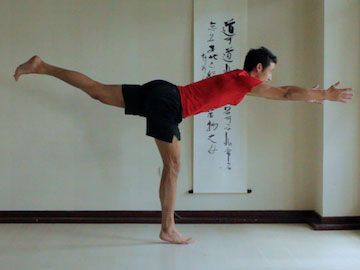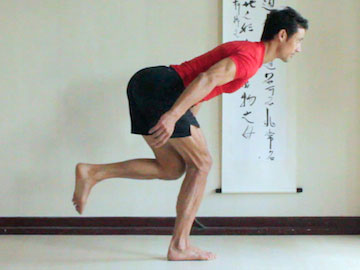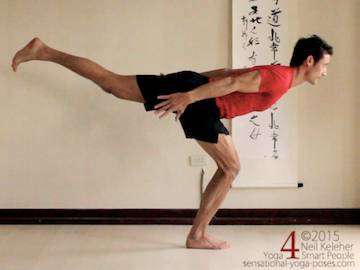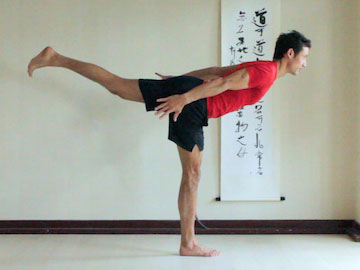Warrior 3
Balancing on One Foot in warrior 3
In Warrior 3 (Virabhadrasana 3) you balance on one foot while reaching your other leg behind you. You can reach your arms back or forwards.
You can also do it with your supporting knee bent (easier) or straight (a stretch for the hamstrings.)
Strengthening the Spinal Erectors
I like to do warrior 3 with the spine bent backwards as much as possible. (Mainly Lumbar spine and thoracic spine.) This helps to strengthen the spinal erectors. At the same time, if you tilt you pelvis forwards then you can lift your lifted leg higher.
Try to keep your back knee pointing downwards and your pelvis level from left to right. To make these actions easier, focus on feeling your standing leg, pelvis and spine.
Making Balance Easier While in Warrior 3
Balancing on one foot is easier if you first activate your standing foot and if you shift your weight forwards enough so that you toes press down. You can then use your toes to help you to balance.
If you find that your standing leg is wobbly you may find it helpful to press the inner thigh of your standing leg forwards while keeping your knee pointing straight ahead.
Bend Your Spine Backwards
When first trying warrior 3 I'd suggest keeping your standing knee bent. Lift your other leg and prior to reaching it back bend your spine backwards. Your pelvis will tilt forwards at the same time. Keep your spine bent backwards and tilt your pelvis forward enough so that your upper body is horizontal.
Keep your lifted knee bent and your arms reaching back for now. Pay attention to your supporting foot. As you reach your leg back keep your weight near the front of your supporting foot so that you toes continue to press down.
Create Length
To create length or space in this pose reach your ribs forwards, away from your pelvis. Reach your head away from your ribcage. You can also focus on opening the spaces between your ribs.
With your spine long reach your arms back. Straighten your elbows and your fingers. Move your shoulder blades towards each other. (Use your rhomboids to do this.)
To make your leg feel long, Reach your lifted knee back, away from it's hip joint. Reach back through your toes as well.
Point Your Knee Down
Alignment instructions help you to improve your body awareness and control by giving you precise guidelines to work toward. Know what you are trying to do so you can recognize both when you are there and when you can't get there.
In the case of warrior 3 those guidelines include making your pelvis level (from left to right) and keeping your back knee pointing down.
You may find it easier to point your back knee down if you allow your outer thigh to relax down while pulling up on the inside of your knee.
Reaching Forwards
Once you are stable with your arms reaching back you can try and reach your arms forwards. Lengthen you neck prior to doing so (pull the back of your head away from your ribcage. As you reach your arms forwards, pay attention to your supporting foot and keep your weight over the same part of your foot.
Straightening Your Standing Leg
If you look at the pictures you'll see that my pelvis is tilted forwards almost 90 degrees to my standing leg.
Warrior 3 is like a forward bend for the standing leg. So as you straighten your standing leg you'll probably notice a stretch at the back of your thigh. Because of this, if you do straighten your standing leg, do it slowly, gradually, or leave it bent.
Bending Your Standing Leg
If you want to strengthen your standing leg in warrior 3 you can try bending your knee more. See how low you can go. Stay aware of your knee as you do this and stop if you notice pain in your knee.
To help preven injury shape or activate your standing foot so that your heel bones are stacked, inner arches lifted and base of little and big toes both press down. Also, if you reach your arm forwards you'll probably notice that this causes your standing knee to move back, so you may find bending the knee is easier if you keep your arms forwards while doing so.
Shift Your Weight
Once you are comfortable in warrior 3 you can practice shifting your weight. Try moving your weight over the front of your foot so that your forefoot and toes press down. You can then lift your heel.
Then try shifting your weight over your heel. In this position you'll be hard pressed to use your toes and so you'll have to concentrate on keeping your center over your heel.
Generally, the stiffer you keep your body in warrior 3 (and in any other balancing posture) the easier it will be to balance.
Note that as well as being a balance pose, this could also be thought of as a back strengthening yoga pose as well as a forward bend.
Published: 2011 04 04








